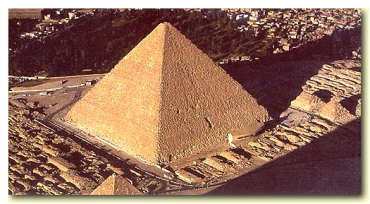
The Surprising Truth Behind the Construction of the Great Pyramids
The widely accepted theory-that the pyramids were crafted of carved-out giant limestone blocks that workers carried up ramps-had not only not been embraced by everyone, but as important had quite a number of holes.
According to the caller, the mysteries had actually been solved by Joseph Davidovits, Director of the Geopolymer Institute in St. Quentin, France, more than two decades ago. Davidovits claimed that the stones of the pyramids were actually made of a very early form of concrete created using a mixture of limestone, clay, lime, and water.
“It was at this point in the conversation that I burst out laughing,” says Barsoum. If the pyramids were indeed cast, he says, someone should have proven it beyond a doubt by now, in this day and age, with just a few hours of electron microscopy.
[…]
A year and a half later, after extensive scanning electron microscope (SEM) observations and other testing, Barsoum and his research group finally began to draw some conclusions about the pyramids. They found that the tiniest structures within the inner and outer casing stones were indeed consistent with a reconstituted limestone. The cement binding the limestone aggregate was either silicon dioxide (the building block of quartz) or a calcium and magnesium-rich silicate mineral.















Wow! Very interesting…
If the limestone blocks of the Egyptian pyramids were indeed cast, why are they so irregular in size and shape? They would have used a several standardized sized of molds for the blocks.
If the blocks were molded, why all the chisel marks? Forming the blocks in molds should reduce the need for chiseling to shape. Also, copper chisels are useless for cutting limestone because they are too soft. You need bronze or iron chisels, or stone hammering tools like the Incas used. What about all the unfinished blocks in the limestone quarries from the period?
A scanning electron microscope isn’t needed to see the obvious visual differences between a block of carved limestone and one cast from limestone-based concrete. I’m wondering if the limestone cement that they’ve found is part of a plaster used to cover the entire pyramid, but is now mostly worn away.
This makes for sense than the theory of carving the stones and dragging them into place. Also explains how the stones were so exactly sized and fit.
I don’t get it. Why should there be any controversy at all? Spectrometers, like the Moessbauer Spectrometer used on Mars to determine precise molecular compositions, would certainly indicate precisely what these blocks are made of.
Anyway, links from Wikipedia:
Egypt’s Zahi Hawass:
“It’s really silly. It was limestone, it’s been studied before by hundreds of chemists,” Hawass, who heads the Supreme Council of Antiquities, said.
http://tinyurl.com/2bwf9t
“These pictures are contradicting Davidovit’s main arguments: neither are the pyramid blocks uniform or regular, neither are they layed out with “1/10th millimeter precision”. Not even his argument of a uniform layer thickness is correct…”
http://doernenburg.alien.de/alternativ/pyramide/pyr17_e.php
RBG
#2 – “If the limestone blocks of the Egyptian pyramids were indeed cast, why are they so irregular in size and shape?”…
Slave Labor…
Archeological science = inexact, lots of guesswork.
Materials science = true engineering discipline
The blocks are made of an old type of concrete. Period.
Makes a lot of sense. They didn’t have plywood back them so the molds would have been made of many pieces of wood. Would have made lots of irregularities that would need to be chiseled off.
i thought the business of how to make this type of cement was relatively cheap, easy and green was really cool
thanks for the link!
They should have hired Teamsters to do it.
If they were cast, why blocks? Why not cast the layers on site?
This also does not explain the King’s chamber, made out of 50+ ton granite blocks. They definitely were not cast.
#4, RBG, I read the second article you linked, very interesting. But the first link, a TinyUrl leads nowhere. Could you repost it? Thanks.
#6, venom monger, I’m not an archaeologist, but it seems the evidence is that Davidovits is mostly incorrect. It’s possible that some of the upper blocks were cast.
“The concrete theorists say that they will be unable to prove their theory conclusively until the Egyptian authorities give them access to substantial samples.”
http://tinyurl.com/2t2sqh
Everybody knows that aliens dropped the blocks into place for the Egyptians. Duh.
#13 – So you’re saying Jesus was a stonemason and not a carpenter?
If this is true…..then it makes them even more a wonder than before. But I suspect that it’s only partly true. From what I could find on this, most of the pyramid is block and only towards the top are these possible concrete block found.
And it is possible that this is somehow tied into the Limestone coating that the whole pyramid was orgiinally covered in.
And there is Alix’s point of the Kings chamber.
#14 – I’m saying that Jesus had a diverse portfolio of talents. He was a carpenter, a stonemason, a landscaper, a roofer, and given his tendency to hang out with a big group of men, he probably also did interior design.
And he probably did far more, too.
Try this again. Should work:
http://tinyurl.com/23z3sc
RBG
#16 – So you’re saying Jesus, our lord and savior, has many things in common with Jesus, who can be found outside of Home Depot?
James…sounds to me like it’s the same dude.
#17, RBG, link works, nice reference, thanks.
“We don’t know the origin of these samples … We certainly never gave permission for anyone to take samples. This well-worn theory keeps coming up for publicity purposes.”
I’m in no position to dispute this story but I’ll say it is very hard to imagine.
This may be the most studied of all ancient sites… and nobody noticed before it was concrete?
This was covered on Quirks and Quarks on January 27, 2007.
http://www.radio.cbc.ca/programs/quirks/archives/06-07/jan27.html
Chariots of the Gods material, so far.
Bird Baths of the Gods?
It should be noted that bird baths are also made of concrete.
#19 – Then why are the liberals in such a hurry to get him in our country, and why are the conservatives in such a hurry to get him out?
#18 – So you’re saying Jesus, our lord and savior, has many things in common with Jesus, who can be found outside of Home Depot?
Comment by James Hill — 5/21/2007 @ 3:41 pm
#19 is right… Jesus, who hangs out in front of Home Depot, is in fact our Lord And Savior.
This is why all good Christians should be in favor of work visas and against building a wall along the southern border of Texas.
(although, I’m not really against building a wall along the northern border of Texas)
#26 – Likewise, it’s why all good Liberals should be against work visas and for building a wall along the southern border of Texas.
After all, a capitalist who wears many hats, like Jesus, isn’t bound to vote for the left his entire life.
#27 – I don’t know where you got the idea that liberals aren’t capitalists. Bill Gates? Warren Buffet? Ted Turner? Steve Jobs? Me?
We are all capitalists.